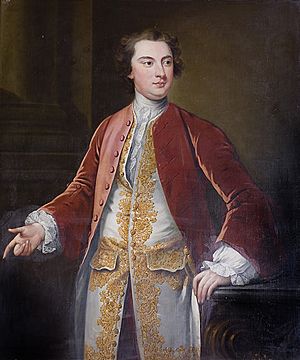Garret Wesley, 1st Earl of Mornington facts for kids
Quick facts for kids
The Earl of Mornington
|
|
|---|---|
 |
|
| Member of Parliament for Trim | |
| In office 1757–1758 Serving with Joseph Ashe
|
|
| Preceded by | Chichester Fortescue Joseph Ashe |
| Succeeded by | William Francis Crosbie Joseph Ashe |
| Personal details | |
| Born | 19 July 1735 Dangan Castle, in County Meath |
| Died | 22 May 1781 (aged 45) |
| Resting place | Grosvenor Chapel |
| Spouses | |
| Relations | Henry Colley (grandfather) |
| Children | Richard Wellesley, 1st Marquess Wellesley Arthur Gerald Wellesley William Wellesley-Pole, 3rd Earl of Mornington Lady Anne Smith Arthur Wellesley, 1st Duke of Wellington Gerald Valerian Wellesley Lady Mary Wellesley Henry Wellesley, 1st Baron Cowley |
| Parents | Richard Wesley, 1st Baron Mornington Elizabeth Sale |
| Alma mater | Trinity College, Dublin |
Garret Colley Wesley, 1st Earl of Mornington (born July 19, 1735 – died May 22, 1781) was an important figure in both politics and music. He was from a powerful family in Ireland and Great Britain. He is also famous for being the father of several well-known leaders. These included military commanders and politicians.
Contents
Early Life and Musical Talent
Garret Wesley was born at Dangan Castle. This was his family's home in County Meath, Ireland. His father was Richard Wesley, 1st Baron Mornington. His mother was Elizabeth Sale.
He went to Trinity College Dublin for his education. In 1764, he became the first Professor of Music there. From a young age, Garret showed amazing skill playing the violin. He soon started writing his own music. He is best known for his "glees." A glee is a type of song for several voices. One famous glee is "Here in cool grot." He also wrote a special church song called a double Anglican chant. Only one of his children, the future Duke of Wellington, inherited some of his musical ability.
A Career in Politics
From 1757 to 1758, Garret Wesley served in the Irish House of Commons. This was like being a Member of Parliament for the area of Trim. In 1758, he took over his father's title as the 2nd Baron Mornington.
In 1759, he became the Custos Rotulorum of Meath. This was a high-ranking official role, like a chief record keeper. In 1760, he received even more honors. Because of his musical achievements and charity work, he was given two new titles. He became Viscount Wellesley and Earl of Mornington.
He was also chosen as the Grand Master of the Grand Lodge of Ireland in 1776. This meant he was the leader of a large group called the Grand Lodge. He held this position for about a year. Like his parents, Garret Wesley had trouble managing money. His early death meant his family faced financial problems. This eventually led to them selling all their family lands in Ireland.
Family Life and Famous Children
On February 6, 1759, Garret Wesley married Anne Hill-Trevor. She was the daughter of a banker named Arthur Hill-Trevor, 1st Viscount Dungannon. Their marriage was a happy one.
They had nine children together. Many of them became very important in history. Here are some of their notable children:
- Richard Wellesley, 1st Marquess Wellesley (1760–1842) was a powerful politician.
- William Wellesley-Pole, 3rd Earl of Mornington (1763–1845) also held important titles.
- Lady Anne Wellesley (1768–1844) married into a noble family.
- Arthur Wellesley, 1st Duke of Wellington (1769–1852) became a famous military leader. He is best known for defeating Napoleon at the Battle of Waterloo.
- Gerald Valerian Wellesley (1770–1848) became a clergyman.
- Henry Wellesley, 1st Baron Cowley (1773–1847) also became a nobleman.
Four of Lord Mornington's five sons received noble titles. These titles were part of the Peerage system in Great Britain and the United Kingdom. Some of these titles, like the Dukedom of Wellington, are still held today. The Earldom of Mornington is now held by the Dukes of Wellington.
Lasting Legacy
Four streets in Camden Town, London, were named after him. These streets were Mornington Crescent, Place, Street, and Terrace. They were part of the land owned by his son-in-law, Henry FitzRoy. Mornington Crescent is now famous as the name of a London Underground station.

